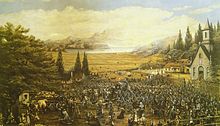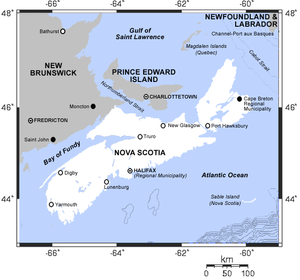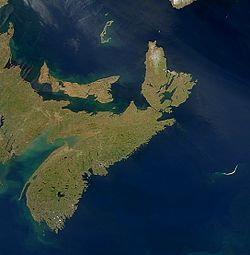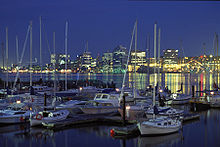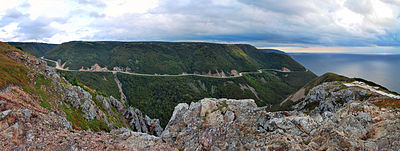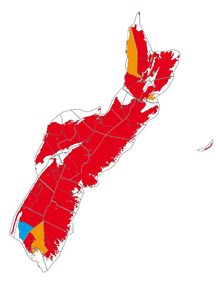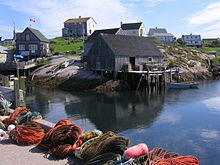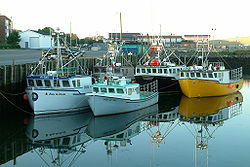- Nova Scotia
-
Nova Scotia
Nouvelle-Écosse (French)
Alba Nuadh (Gaelic)

Flag Coat of arms Motto: Munit Haec et Altera Vincit
(Latin: One defends and the other conquers)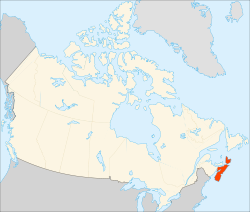
Capital Halifax Largest city Halifax Largest metro Halifax Official languages English (de facto) Demonym Nova Scotian Government Type Constitutional monarchy Lieutenant-Governor Mayann Francis Premier Darrell Dexter (NDP) Legislature Nova Scotia House of Assembly Federal representation in Canadian parliament House seats 11 Senate seats 10 Confederation July 1, 1867 (1st, with ON, QC, NB) Area Ranked 12th Total 55,283 km2 (21,345 sq mi) Land 53,338 km2 (20,594 sq mi) Water (%) 1,946 km2 (751 sq mi) (3.5%) Population Ranked 7th Total (2011) 946,397 (est.)[1] Density 17.74 /km2 (45.9 /sq mi) GDP Ranked 7th Total (2009) C$34.283 billion[2] Per capita C$34,210 (11th) Abbreviations Postal NS ISO 3166-2 CA-NS Time zone UTC-4 Postal code prefix B Flower Mayflower Tree Red spruce Bird Osprey Website www.gov.ns.ca Rankings include all provinces and territories Coordinates: 45°13′N 62°42′W / 45.217°N 62.7°W
Nova Scotia (pronounced /ˌnoʊvə ˈskoʊʃə/; French: Nouvelle-Écosse; Scottish Gaelic: Alba Nuadh)[3] is one of Canada's three Maritime provinces and is the most populous province in Atlantic Canada. The name of the province is Latin for "New Scotland," but "Nova Scotia" is the recognized, English-language name of the province. The provincial capital is Halifax. Nova Scotia is the second-smallest province in Canada with an area of 55,284 square kilometres (21,300 sq mi). As of 2009, the population is 946,397,[4] which makes Nova Scotia the second-most-densely populated province.
Nova Scotia was already home to the Mi'kmaq people when French colonists established the first permanent European settlement in Canada and the first north of Florida in 1604. In 1867 Nova Scotia was one of the four founding provinces of the Canadian Confederation.[5]
Tourist bureaus portray Nova Scotia as a province whose true essence is found in primitive, rustic, and unspoiled traditions outside the process of modernization, and highlight all things Scottish.[6] People with Scottish ancestry are the largest self-identified ethnic group in the province after Canadian (that population is 29.3% as of 2011).
Contents
History
Overview
The province includes regions of the Mi'kmaq nation of Mi'kma'ki (mi'gama'gi).[7] Nova Scotia was already home to the Mi'kmaq people when the first European colonists arrived. In 1604, French colonists established the first permanent European settlement in Canada and the first north of Florida at Port Royal, founding what would become known as Acadia.
The British Conquest of Acadia took place in 1710. It was formally recognized in 1713 by the Treaty of Utrecht. Cape Breton Island (Île Royale) was returned to the French in the Treaty of Utrecht. What is now New Brunswick was still a part of the French colony of Acadia. The name of the capital was changed from Port Royal to Annapolis Royal, Nova Scotia. The capital of Nova Scotia was changed from Annapolis Royal to the newly established Halifax in 1749. In 1755, the vast majority of the French population (the Acadians) were expelled and replaced by 8,000 immigrants who came from the New England colonies and arrived between 1759-1768.
In 1763, most of Acadia (Cape Breton Island, St. John's Island (now Prince Edward Island) and New Brunswick) became part of Nova Scotia. In 1769, St. John's Island became a separate colony. Nova Scotia included present-day New Brunswick until that province was established in 1784 after the arrival of United Empire Loyalists.[8] In 1867 Nova Scotia was one of the four founding provinces of the Canadian Confederation.[5]
17th and 18th centuries
The history of Nova Scotia was significantly influenced by the warfare that took place on its soil during the 17th and 18th centuries.[9] Until that time period, the Mi’kmaq had lived in Nova Scotia for centuries. The French arrived in 1604, and Catholic Mi’kmaq and Acadians were the predominant populations in the colony for the next 150 years. During the first 80 years the French and Acadians were in Nova Scotia, there were nine significant battles as the English, Scottish, Dutch and French fought for possession of the colony. These battles happened at Port Royal, Saint John,[10] Cap de Sable (present-day Port La Tour, Nova Scotia), Jemseg and Baleine.
Beginning with King Williams War in 1689, there were six wars in Nova Scotia before the British defeated the French, Acadians, and Mi’kmaq:
- King Williams War (1689–1697),
- Queen Annes War (1702–1713),
- Dummer's War (1722–1725),
- King Georges War (1744–1748),
- Father Le Loutre’s War (1749–1755) and the
- French and Indian War (1754–1763)
The battles during these wars were primarily fought at Port Royal, Saint John, Canso, Chignecto, Dartmouth, Lunenburg and Grand-Pré.
Despite the British Conquest of Acadia in 1710, Nova Scotia remained primarily occupied by Catholic Acadians and Mi'kmaq. A generation later, Father Le Loutre's War began when Edward Cornwallis arrived to establish Halifax with 13 transports on June 21, 1749.[11] During the French and Indian War the Acadians were deported and the New England Planters were brought to the colony to take their place. After the war, the Acadians were allowed to return and treaties were made with the Mi’kmaq.
The American Revolution (1776–1783) also had a significant impact on shaping Nova Scotia. Throughout the war, American privateers devastated the maritime economy by raiding many of the coastal communities. Raids happened regularly on Lunenburg, Annapolis Royal, Canso and Liverpool.[12] There were also two naval battles: the Naval battle off Halifax and another off Sydney, Cape Breton. There was ambivalence in Nova Scotia—the 14th American Colony—over whether or not the colony should join the Americans in the rebellion against Britain (See Battle of Fort Cumberland and the Siege of Saint John (1777)). As a result of the British defeat, approximately 30,000 United Empire Loyalists (American Tories) settled Nova Scotia (which was divided and the present-day province of New Brunswick created). Approximately 3,000 of this group were Black Loyalists.[13]
19th century
During the War of 1812, Nova Scotia’s contribution to the war effort was communities either purchasing or building various privateer ships to lay siege to American vessels.[14] Perhaps the most dramatic moment in the war for Nova Scotia was when HMS Shannon escorted the captured American frigate USS Chesapeake into Halifax Harbour (1813). Many of the prisoners were kept at Deadman's Island, Halifax.
During this century, Nova Scotia was the first colony in British North America and in the British Empire to achieve responsible government in January–February 1848 and become self-governing through the efforts of Joseph Howe.[15] (In 1758, Nova Scotia also became the first British colony to establish representative government, an achievement that was later commemorated by erecting the Dingle Tower (1908).)
Thousands of Nova Scotians fought in the American Civil War (1861–1865), primarily for the North.[16] The British Empire (including Nova Scotia) was declared neutral in the struggle between the North and the South. As a result, Britain (and Nova Scotia) continued to trade with both the South and the North. Nova Scotia’s economy boomed during the Civil War.
Immediately after the Civil War, Pro-Confederate premier Charles Tupper led Nova Scotia into the Canadian Confederation on July 1, 1867, along with New Brunswick and the Province of Canada. The Anti-Confederation Party was led by Joseph Howe. Almost three months later, in the election of September 18, 1867, the Anti-Confederation Party, won 18 out of 19 federal seats, and 36 out of 38 seats in the provincial legislature.
In the 19th century, Nova Scotia became a world leader in both building and owning wooden sailing ships in the second half of the 19th century. Nova Scotia produced internationally recognized shipbuilders Donald McKay and William Dawson Lawrence. The fame Nova Scotia achieved from sailors was assured when Joshua Slocum became the first man to sail single-handedly around the world (1895). This international attention continued into the following century with the many racing victories of the Bluenose schooner. Nova Scotia was also the birthplace and home of Samuel Cunard, a British shipping magnate, born at Halifax, Nova Scotia, who founded the Cunard Line.
Geography
Nova Scotia is Canada's second-smallest province in area after Prince Edward Island. The province's mainland is the Nova Scotia peninsula surrounded by the Atlantic Ocean, including numerous bays and estuaries. Nowhere in Nova Scotia is more than 67 km (42 mi) from the ocean.[17] Cape Breton Island, a large island to the northeast of the Nova Scotia mainland, is also part of the province, as is Sable Island, a small island notorious for its shipwrecks, approximately 175 km (110 mi) from the province's southern coast.
Climate
Nova Scotia lies in the mid-temperate zone and, although the province is almost surrounded by water, the climate is closer to continental rather than maritime. The temperature extremes of the continental climate are moderated by the ocean.
Described on the provincial vehicle-licence plate as Canada's Ocean Playground, the sea is a major influence on Nova Scotia's climate. Nova Scotia's cold winters and warm summers are modified and generally moderated by ocean influences. The province is surrounded by three major bodies of water, the Gulf of Saint Lawrence to the north, the Bay of Fundy to the west, and the Atlantic Ocean to the south and east.
While the constant temperature of the Atlantic Ocean moderates the climate of the south and east coasts of Nova Scotia, heavy ice build-up in the Gulf of Saint Lawrence makes winters colder in northern Nova Scotia; the shallowness of the Gulf's waters mean that they warm up more than the Atlantic Ocean in the summer, warming the summers in northern Nova Scotia. Summer officially lasts from the first Sunday in April to the Saturday before the last Sunday in October. Although Nova Scotia has a somewhat moderated climate, there have been some very intense heatwaves and cold snaps recorded over the past 160 years. The highest temperature ever recorded in the province was 38.3 °C (101 °F) on August 19, 1935, at Collegeville,[18] which is located about 15 km southwest of Antigonish. The coldest temperature ever recorded was −41.1 °C (−42 °F) on January 31, 1920, at Upper Stewiacke.[19]
The highest temperature ever recorded in the city of Halifax was 37.2 °C (99 °F) on July 10, 1912,[20] and the lowest was −29.4 °C (−21 °F) on Feb 18th, 1922.[21] For the city of Sydney, the highest temperature ever recorded was 36.7 °C (98 °F) on August 18, 1935,[22] and the lowest was −31.7 °C (−25 °F) on January 31, 1873,[23] and January 29, 1877 [24]
Rainfall changes from 140 centimetres (55 in) in the south to 100 centimetres (40 in) elsewhere. Nova Scotia is also very foggy in places, with Halifax averaging 196 foggy days per year[25] and Yarmouth 191.[26]
The average annual temperatures are:
- Spring from 1 °C (34 °F) to 17 °C (63 °F)
- Summer from 14 °C (57 °F) to 28 °C (82 °F)[27]
- Fall about 5 °C (41 °F) to 20 °C (68 °F)
- Winter about −20 °C (−4 °F) to 5 °C (41 °F)
Due to the ocean's moderating effect Nova Scotia is the warmest of the provinces in Canada.[citation needed] It has frequent coastal fog and marked changeability of weather from day to day. The main factors influencing Nova Scotia's climate are:
- The effects of the westerly winds
- The interaction between three main air masses which converge on the east coast
- Nova Scotia's location on the routes of the major eastward-moving storms
- The modifying influence of the sea.
Because Nova Scotia juts out into the Atlantic, it is prone to tropical storms and hurricanes in the summer and autumn. However due to the relatively cooler waters off the coast of Nova Scotia, tropical storms are usually weak by the time they reach Nova Scotia. There have been 33 such storms, including 12 hurricanes, since records were kept in 1871 – about once every four years. The last hurricane was category-one Hurricane Earl in September 2010, and the last tropical storm was Tropical Storm Noel in 2007 (downgraded from Hurricane Noel by the time the storm reached Nova Scotia).
Government and politics
Nova Scotia is ordered by a parliamentary government within the construct of constitutional monarchy; the monarchy in Nova Scotia is the foundation of the executive, legislative, and judicial branches.[28] The sovereign is Queen Elizabeth II, who also serves as head of state of 15 other Commonwealth countries, each of Canada's nine other provinces, and the Canadian federal realm, and resides predominantly in the United Kingdom. As such, the Queen's representative, the Lieutenant Governor of Nova Scotia (presently Mayann E. Francis), carries out most of the royal duties in Nova Scotia.
The direct participation of the royal and viceroyal figures in any of these areas of governance is limited, though; in practice, their use of the executive powers is directed by the Executive Council, a committee of ministers of the Crown responsible to the unicameral, elected House of Assembly and chosen and headed by the Premier of Nova Scotia (presently Darrell Dexter), the head of government. To ensure the stability of government, the lieutenant governor will usually appoint as premier the person who is the current leader of the political party that can obtain the confidence of a plurality in the House of Assembly. The leader of the party with the second-most seats usually becomes the Leader of Her Majesty's Loyal Opposition (presently Stephen McNeil) and is part of an adversarial parliamentary system intended to keep the government in check.[29]
Each of the 52 Members of the Legislative Assembly in the House of Assembly is elected by single member plurality in an electoral district or riding. General elections must be called by the lieutenant governor on the advice of the premier, or may be triggered by the government losing a confidence vote in the House.[30] There are three dominant political parties in Nova Scotia: the Liberal Party, the New Democratic Party, and the Progressive Conservative Party.
The province's revenue comes mainly from the taxation of personal and corporate income, although taxes on tobacco and alcohol, its stake in the Atlantic Lottery Corporation, and oil and gas royalties are also significant. In 2006-07, the province passed a budget of $6.9 billion, with a projected $72 million surplus. Federal equalization payments account for $1.385 billion, or 20.07% of the provincial revenue. The province participates in the HST, a blended sales tax collected by the federal government using the GST tax system.
Nova Scotia no longer has any incorporated cities; they were amalgamated into Regional Municipalities in 1996.
Culture
Fine arts
Nova Scotia has long been a centre for artistic and cultural excellence. The capital city of Halifax hosts institutions such as Nova Scotia College of Art and Design University, Art Gallery of Nova Scotia, Neptune Theatre, Two Planks and a Passion Theatre, Ship's Company Theatre and the Symphony Nova Scotia, the only full orchestra performing in Atlantic Canada. The province is home to avant-garde visual art and traditional crafting, writing and publishing and a film industry.
Film and television
Nova Scotia has produced numerous film actors. Academy Award nominee Ellen Page (Juno, Inception) lives in Nova Scotia; five time Academy Award nominee Arthur Kennedy (Lawrence of Arabia, High Sierra) called Nova Scotia his home; and two time Golden Globe winner Donald Sutherland (MASH, Ordinary People) spent most of his youth in the province. Other actors include John Paul Tremblay (Trailer Park Boys). Nova Scotia has also produced numerous film directors such as Thom Fitzgerald (The Hanging Garden) and Daniel Petrie (Resurrection—Academy Award nominee).
Nova Scotian stories are the subject of numerous feature films: Margaret's Museum (starring Helena Bonham Carter); The Bay Boy (directed by Daniel Petrie and starring Kiefer Sutherland); New Waterford Girl; and Evangeline (starring Miriam Cooper).
There is a significant film industry in Nova Scotia. Some of the Academy Award winning feature films that have been made in the province are: Titanic (starring Leonardo Dicaprio and Kate Winslet); Bowling for Columbine (starring Michael Moore); and The Shipping News (starring Kevin Spacey and Cate Blanchett). Other films include K-19: The Widowmaker (starring Harrison Ford and Liam Neeson).
Nova Scotia has also produced numerous television series: This Hour has 22 Minutes, Don Messer's Jubilee, Black Harbour, Haven, Trailer Park Boys and Theodore Tugboat.
Literature
There are numerous Nova Scotian authors who have achieved international fame: Thomas Chandler Haliburton (The Clockmaker); Alister MacLeod (No Great Mischief); and Margaret Marshall Saunders (Beautiful Joe). Other authors include Johanna Skibsrud (The Sentamentalist), Alden Nowlan (Bread, Wine and Salt), George Elliott Clarke (Execution Poems), Lesley Choyce (Nova Scotia: Shaped by the Sea), Thomas Raddall (Halifax: Warden of the North), Donna Morrissey (Kit's Law), Frank Parker Day (Rockbound).
Nova Scotia has also been the subject of numerous literary books. Some of the international best-sellers are: Last Man Out: The Story of the Springhill Mining Disaster (by Melissa Fay Greene) ; Curse of the Narrows: The Halifax Explosion 1917 (by Laura MacDonald); "In the Village" (short story by Pulitzer Prize–winning author Elizabeth Bishop); and National Book Critics Circle Award winner Rough Crossings (by Simon Schama). Other authors who have written novels about Nova Scotian stories include: Linden MacIntyre (The Bishop's Man); Hugh MacLennan (Barometer Rising); Ernest Buckler (The Valley and the Mountain); Archibald MacMechan (Red Snow on Grand Pré), Henry Wadsworth Longfellow (long poem Evangeline); Lawrence Hill (The Book of Negroes) and John Mack Faragher (Great and Nobel Scheme).
Music
Nova Scotia has produced numerous musicians. The Grammy Award winners include Denny Doherty (from The Mamas & the Papas), Anne Murray, and Sarah McLachlan. Other musicians include: country singer George Canyon, jazz singer Holy Cole; multi-Juno nominated rapper Classified, Rita MacNeil, Sloan, The Rankin Family, Buck 65, Joel Plaskett and Grand Derangement.
There are numerous songs written about Nova Scotia: The Ballad of Springhill (written by Peggy Seeger and performed by U2 – See video); numerous songs by Stan Rogers including Bluenose and Barrett's Privateers; Farewell to Nova Scotia (traditional); She’s Called Nova Scotia (by Rita MacNeil); Cape Breton (by David Myles); Acadian Driftwood (by Robbie Robertson) and My Nova Scotia Home (by Hank Snow).
Nova Scotia has also produced some significant song writers such as Grammy Award winning Gordie Sampson. Sampson has written songs for Carrie Underwood ("Jesus, Take the Wheel", "Just a Dream", "Get Out of This Town"), Martina McBride ("If I Had Your Name",You're Not Leavin Me"), LeAnn Rimes ("Long Night", "Save Myself"), and George Canyon ("My Name"). Another successful Nova Scotia song writer was Hank Snow whose songs has been recorded by The Rolling Stones, Elvis Presley, and Johnny Cash.
Sports
Sport is an important part of Nova Scotia culture. There are numerous professional sports teams. Nova Scotia has also produced numerous athletes such as Sidney Crosby (hockey), Brad Marchand (hockey), Colleen Jones (curling), Al MacInnis (hockey), Rocky Johnson (wrestling) and George Dixon (boxer). The achievements of Nova Scotian athletes are presented at the Nova Scotia Sport Hall of Fame.
Tourism
See Nova Scotia—Wiki Travel Guide
Nova Scotia's tourism industry showcases Nova Scotia's culture. There are centres that tell the stories of the province's internationally renowned musicians: Hank Snow Home Town Museum (Liverpool), Rita McNiel's Tea Room (Big Pond), and the Anne Murray Centre (Springhill).
Nova Scotia also has an array of centres and museums which reflect the various communities that make up the province's culture: Black Cultural Centre for Nova Scotia, Grand-Pré National Historic Site, Glooscap Heritage Centre, Glace Bay Miners Museum, and the Maritime Museum of the Atlantic.
There are also numerous music festivals throughout the province such as the Stan Rogers Folk Festival, the Halifax Jazz Festival, the Lunenburg Folk Harbour Festival, Celtic Colours, Deep Roots Music Festival, Clare Acadian Festival, Nova Scotia Multicultural Festival, the Nova Scotia Gaelic Mod and the Royal Nova Scotia International Tattoo. Nova Scotia also hosts the annual Atlantic Film Festival and the Atlantic Fringe Festival.
The province has numerous historical museums. The most notable being Habitation at Port-Royal, Fortress of Louisbourg and Citadel Hill (Fort George).
Nova Scotia's culture is also shaped by the environment. The highlights include going around the Cabot Trail, Whale Watching off of Brier Island, riding the waves or walking on the ocean floor of the Bay of Fundy (the location of the world's highest tides at Burncoat Head) and visiting the rocky landscape of Peggys Cove.
Demographics
Population since 1851
Year Population Five Year
% changeTen Year
% change1851 276,854 n/a n/a 1861 330,857 n/a 19.5 1871 387,800 n/a 17.2 1881 440,572 n/a 13.6 1891 450,396 n/a 2.2 1901 459,574 n/a 2.0 1911 492,338 n/a 7.1 1921 523,837 n/a 6.4 1931 512,846 n/a -2.1 1941 577,962 n/a 12.7 1951 642,584 n/a 11.2 1956 694,717 8.1 n/a 1961 737,007 6.1 14.7 1966 756,039 2.6 8.8 1971 788,965 4.4 7.0 1976 828,570 5.0 9.6 1981 847,442 2.3 7.4 1986 873,175 3.0 5.4 1991 899,942 3.1 6.2 1996 909,282 1.0 4.1 2001 908,007 -0.1 0.9 2006 913,462 0.6 0.5 2011 946,397 3.6 4.2 Top ten counties by population
County 2001 2006 Halifax (county) 359,183 372,858 Cape Breton (county) 109,330 105,928 Kings County 58,866 60,035 Colchester County 49,307 50,023 Lunenburg County 47,591 47,150 Pictou County 46,965 46,513 Hants County 40,513 41,182 Cumberland County 32,605 32,046 Yarmouth County 26,843 26,277 Annapolis County 21,773 21,438 Ethnic origins
According to the 2006 Canadian census[32] the largest ethnic group in Nova Scotia is Scottish (28.3%), followed by English (28.1%), Irish (19.9%), French (17.7%), Aboriginal origin (10.2%), German (10.0%), Dutch (3.9%), African Canadian (2.3%), Italian (1.3%), and Acadian (1.2%). Almost half of respondents (47.4%) identified their ethnicity as "Canadian".
Nova Scotia has a long history of social justice work to address issues such as racism and sexism within its borders. The province in Atlantic Canada continues to battle racism with an annual march to end racism against people of African descent.[33][34]
Language
The 2006 Canadian census showed a population of 913,462.
Of the 899,270 singular responses to the census question concerning "mother tongue" the most-commonly reported languages were:Rank Language Respondents Percentage 1. English 833,105 92.53% 2. French 32,540 3.62% 3. Arabic 4,425 0.49% 4. Mi'kmaq 4,060 0.45% 5. German 4,045 0.45% 6. Chinese 3,370 0.37% 7. Dutch 2,440 0.27% 8. Polish 1,570 0.17% 9. Spanish 1,305 0.15% 10. Greek 1,035 0.12% 11. Italian 905 0.10% 12. Korean 860 0.10% 13. Gaelic 799 0.10% In addition, there were also 105 responses of both English and a "non-official language"; 25 of both French and a "non-official language"; 495 of both English and French; 10 of English, French, and a "non-official language"; and about 10,300 people who either did not respond to the question, or reported multiple non-official languages, or else gave another unenumerated response. Figures shown are for the number of single language responses and the percentage of total single-language responses.[35]
Religion
The largest denominations by number of adherents according to the 2001 census were the Roman Catholic Church with 327,940 (37 %); the United Church of Canada with 142,520 (16 %); and the Anglican Church of Canada with 120,315 (13 %).[36]
Economy
Nova Scotia's traditionally resource-based economy has become more diverse in recent decades. The rise of Nova Scotia as a viable jurisdiction in North America was driven by the ready availability of natural resources, especially the fish stocks off the Scotian shelf. The fishery was pillar of the economy since its development as part of the economy of New France in the 17th century; however, the fishery suffered a sharp decline due to overfishing in the late 20th century. The collapse of the cod stocks and the closure of this sector resulted in a loss of approximately 20,000 jobs in 1992.[37] Per capita GDP in 2005 was $31,344,[38] lower than the national average per capita GDP of $34,273 and less than half that of Canada's richest province, Alberta.
Due, in part, to a strong small-business sector, Nova Scotia now has one of the fastest-growing economies in Canada.[39] Mining, especially of gypsum and salt and to a lesser extent silica, peat and barite, is also a significant sector.[40] Since 1991, offshore oil and gas has become an increasingly important part of the economy. Agriculture remains an important sector in the province. In the central part of Nova Scotia, lumber and paper industries are responsible for much of the employment opportunities.
Nova Scotia’s defence and aerospace sector generates approximately $500 million in revenues and contributes about $1.5 billion to the provincial economy annually.[41] To date, 40% of Canada’s military assets reside in Nova Scotia.[42] Nova Scotia has the fourth-largest film industry in Canada hosting over 100 productions yearly, more than half of which are the products of international film and television producers.[43] Recently, the video game industry has grown with the emergence of developers such as HB Studios and Silverback Productions. The province made international headlines with an investment by Longtail Studios in 2009.[44]
The Nova Scotia tourism industry includes more than 6,500 direct businesses, supporting nearly 40,000 jobs.[45] 200,000 cruise ship passengers from around the world flow through the Port of Halifax, Nova Scotia each year.[46] This industry contributes approximately $1.3 billion annually to the economy.[47] The province also boasts a rapidly developing Information & Communication Technology (ICT) sector which consists of over 500 companies, and employs roughly 15,000 people.[48] The Life Sciences sector in the province is flourishing; some of the most innovative life sciences companies in the world can be found in Nova Scotia.[49] In 2006, the manufacturing sector brought in over $2.6 billion in chained GDP, the largest output of any industrial sector in Nova Scotia.[50] There are currently over 360 firms in the Insurance Industry of Nova Scotia; there is a forecasted 25% growth in employment for this industry in the province over the next three years.[51]
The average income of a Nova Scotian family is $47,100, the gross ranking close to the national average; for Halifax, the average family income is $58,262, which far surpasses the national average.[citation needed] This, along with the province’s highly affordable real estate, makes Nova Scotia a cost-effective place to live.[52] Halifax ranks among the top five most cost-effective places to do business when compared to large international centres in North America, Europe and Asia-Pacific.[53]
Nova Scotia has a number of incentive programs, including tax refunds and credits that work to encourage small business growth.[54] The province is attracting major companies from all over the world that will help fuel the economy and provide jobs; companies like Research in Motion (RIM) and Lockheed Martin have seen the value of Nova Scotia and established branches in the province.[55]
Though only the second smallest province in Canada, Nova Scotia is a recognized exporter. The province is the world’s largest exporter of Christmas trees, lobster, gypsum, and wild berries.[56] Its export value of fish exceeds $1 billion, and fish products are received by 90 countries around the world.[57]
Education
The Minister of Education is responsible for the administration and delivery of education, as defined by the Education Act[58] and other acts relating to colleges, universities and private schools. The powers of the Minister and the Department of Education are defined by the Ministerial regulations and constrained by the Governor-In-Council regulations.
Nova Scotia has more than 450 public schools for children. The public system offers primary to Grade 12. There are also private schools in the province. Public education is administered by seven regional school boards, responsible primarily for English instruction and French immersion, and also province-wide by the Conseil Scolaire Acadien Provincial, which administer French instruction to students for whom the primary language is French.
The Nova Scotia Community College system has 13 campuses around the province. The community college, with its focus on training and education, was established in 1988 by amalgamating the province's former vocational schools.
In addition to its community college system the province has 11 universities, including Dalhousie University, University of King's College, Saint Mary's University (Halifax), Mount Saint Vincent University, NSCAD University, Acadia University, Université Sainte-Anne, Saint Francis Xavier University, Nova Scotia Agricultural College, Cape Breton University and the Atlantic School of Theology.
There are also more than 90 registered private commercial colleges in Nova Scotia.[59]
See also
- Bibliography of Nova Scotia
- Index of Nova Scotia-related articles
- Cape Breton Regional Municipality, Nova Scotia
- Central Nova Tourist Association
- Emergency Health Services in Nova Scotia
- Goler clan
- Kejimkujik National Park
- Royal Nova Scotia Yacht Squadron
- Petroleum pricing in Nova Scotia
- Same-sex marriage in Nova Scotia
- Scouting and Guiding in Nova Scotia
- Symbols of Nova Scotia
- Wikiproject Nova Scotia
- List of rivers of Nova Scotia
- List of airports in Nova Scotia
- List of articles on Nova Scotia by topic
- List of renowned Nova Scotians
- List of Nova Scotia schools
- List of parks in Nova Scotia
- List of Nova Scotia counties
- List of communities in Nova Scotia
- List of colleges and universities in Nova Scotia
- List of Nova Scotia lieutenant-governors
- List of Nova Scotia premiers
- List of Nova Scotia provincial highways
Notes
- ^ "Canada's population estimates: Table 2 Quarterly demographic estimates". Statcan.gc.ca. 2010-06-28. http://www.statcan.gc.ca/daily-quotidien/100628/t100628a2-eng.htm. Retrieved 2010-06-30.
- ^ "Gross domestic product, expenditure-based, by province and territory". 0.statcan.ca. 2009-11-10. http://www40.statcan.ca/l01/cst01/econ15.htm. Retrieved 2010-10-06.
- ^ Latin: Nova Scotia; English: New Scotland;Scottish Gaelic: Alba Nuadh
- ^ Statistics Canada. "Canada's population estimates 2009-12-23". http://www.statcan.gc.ca/daily-quotidien/091223/t091223b2-eng.htm. Retrieved 2010-01-01.
- ^ a b The other three provinces were New Brunswick and the Province of Canada (which became the separate provinces of Quebec and Ontario).
- ^ Ian MacKay, In the Province of History: The Making of the Public Past in Twentieth-Century Nova Scotia. (Queen's-McGill University Press. 2010) pp 254-55
- ^ the Nation of Mi'kma'ki also includes the Maritimes, parts of Maine, Newfoundland and the Gaspé Peninsula.
- ^ In 1765, the county of Sunbury was created. This included the territory of present-day New Brunswick and eastern Maine as far as the Penobscot River.
- ^ John G. Reid. An International Region of the Northeast: Rise and Decline, 1635-1762. In Buckner, Campbell and Frank (eds) The Acadiensis Reader: Volume 1. Third Edtion. 1998. p. 31
- ^ Until 1784, New Brunswick was considered part of Nova Scotia.
- ^ Grenier, John. The Far Reaches of Empire. War in Nova Scotia, 1710-1760. Norman: U of Oklahoma P, 2008; Thomas Beamish Akins. History of Halifax, Brookhouse Press. 1895. (2002 edition). p 7
- ^ Roger Marsters (2004). Bold Privateers: Terror, Plunder and Profit on Canada's Atlantic Coast, p. 87–89.
- ^ About a third of whom soon moved themselves to Sierra Leone in 1792 with the help of the Committee for the Relief of the Black Poor, becoming the Original settlers of Freetown.
- ^ John Boileau. Half-hearted Enemies: Nova Scotia, New England and the War of 1812. Halifax: Formac Publishing. 2005. p.53
- ^ Beck, J. Murray. (1983) Joseph Howe: The Briton Becomes Canadian 1848–1873. (v.2). Kingston & Montreal: McGill-Queen's University Press. ISBN 0-7735-0388-9
- ^ Marquis, Greg. In Armageddon’s Shadow: The Civil War and Canada’s Maritime Provinces. McGill-Queen’s University Press. 1998.
- ^ Ted Harrison (1993). O Canada. Ticknor & Fields.
- ^ "Environment Canada". Climate.weatheroffice.gc.ca. 2010-08-18. http://climate.weatheroffice.gc.ca/climate_normals/results_e.html?StnID=6329&autofwd=1. Retrieved 2010-10-06.
- ^ "Environment Canada". Climate.weatheroffice.gc.ca. 2010-08-18. http://climate.weatheroffice.gc.ca/climate_normals/results_e.html?StnID=6495&autofwd=1. Retrieved 2010-10-06.
- ^ "Environment Canada". Climate.weatheroffice.gc.ca. 2010-08-18. http://climate.weatheroffice.gc.ca/climateData/dailydata_e.html?timeframe=1&Prov=XX&StationID=6355&Year=1912&Month=7&Day=1. Retrieved 2010-10-06.
- ^ "Environment Canada". Climate.weatheroffice.gc.ca. 2010-08-18. http://climate.weatheroffice.gc.ca/climateData/dailydata_e.html?timeframe=2&Prov=CA&StationID=6355&Year=1922&Month=2&Day=27. Retrieved 2010-10-06.
- ^ "Environment Canada". Climate.weatheroffice.gc.ca. 2010-08-18. http://climate.weatheroffice.gc.ca/climateData/dailydata_e.html?timeframe=2&Prov=CA&StationID=6485&Year=1935&Month=8&Day=27. Retrieved 2010-10-06.
- ^ "Environment Canada". Climate.weatheroffice.gc.ca. 2010-08-18. http://climate.weatheroffice.gc.ca/climateData/dailydata_e.html?timeframe=1&Prov=XX&StationID=6485&Year=1873&Month=1&Day=1. Retrieved 2010-10-06.
- ^ "Environment Canada". Climate.weatheroffice.gc.ca. 2010-08-18. http://climate.weatheroffice.gc.ca/climateData/dailydata_e.html?timeframe=1&Prov=XX&StationID=6485&Year=1877&Month=1&Day=1. Retrieved 2010-10-06.
- ^ "Historical Weather for Halifax, Nova Scotia, Canada". Weatherbase. http://www.weatherbase.com/weather/weatherall.php3?s=59317&refer=&units=us. Retrieved 2010-10-06.
- ^ "Historical Weather for Yarmouth, Nova Scotia, Canada". Weatherbase. http://www.weatherbase.com/weather/weatherall.php3?s=30617&refer=&units=us. Retrieved 2010-10-06.
- ^ Environment Canada - Atlantic Climate Centre - The Climate of Nova Scotia[dead link]
- ^ Canadian Heritage (February 2009). Canadian Heritage Portfolio (2nd ed.). Queen's Printer for Canada. pp. 3–4. ISBN 978-1-100-11529-0. http://www.pch.gc.ca/pc-ch/publctn/gp-pg/ppc-chp/ppc-chp-eng.pdf. Retrieved 23 May 2011.
- ^ Library of Parliament. "The Opposition in a Parliamentary System". Queen's Printer for Canada. http://www.parl.gc.ca/Content/LOP/researchpublications/bp47-e.htm. Retrieved 23 May 2011.
- ^ Dawson, R. MacGregor; Dawson, WF (1989). Ward, Norman. ed. Democratic Government in Canada. University of Toronto Press. pp. 16–17, 59–60, 66. ISBN 0-8020-6703-4.
- ^ "Nova Scotia - Canada's population clock". Statcan.gc.ca. 2010-11-18. http://www.statcan.gc.ca/ig-gi/pop-ns-eng.htm. Retrieved 2011-08-29.
- ^ Statistics Canada (January 2005). "Population by selected ethnic origins, by province and territory (Census 2006)". http://www12.statcan.gc.ca/census-recensement/2006/dp-pd/prof/92-591/details/page.cfm?Lang=E&Geo1=CSD&Code1=1209034&Geo2=PR&Code2=12&Data=Count&SearchText=halifax&SearchType=Begins&SearchPR=01&B1=All&Custom=. Retrieved 2011-10-03.
- ^ "BreakingNews – Protest targets racism in Halifax". TheSpec.com. 2010-02-23. http://www.thespec.com/News/BreakingNews/article/727177. Retrieved 2010-07-26.
- ^ Ottawa Citizen - Google News Archive Search
- ^ "Detailed Mother Tongue (186), Knowledge of Official Languages (5), Age Groups (17A) and Sex (3) (2006 Census)". 2.statcan.ca. 2010-05-19. http://www12.statcan.ca/english/census06/data/topics/RetrieveProductTable.cfm?ALEVEL=3&APATH=3&CATNO=&DETAIL=0&DIM=&DS=99&FL=0&FREE=0&GAL=0&GC=99&GK=NA&GRP=1&IPS=&METH=0&ORDER=1&PID=89201&PTYPE=88971&RL=0&S=1&ShowAll=No&StartRow=1&SUB=701&Temporal=2006&Theme=70&VID=0&VNAMEE=&VNAMEF=&GID=837934. Retrieved 2010-10-06.
- ^ "Religions in Canada". 2.statcan.ca. http://www12.statcan.ca/english/census01/products/highlight/Religion/Page.cfm?Lang=E&Geo=PR&View=1a&Code=12&Table=1&StartRec=1&Sort=2&B1=12&B2=All. Retrieved 2010-10-06.
- ^ Fish in Crisis. "The Starving Ocean". http://www.fisherycrisis.com. Retrieved 2007-04-26.
- ^ Government of Nova Scotia (2007). "Economics and Statistics". http://www.gov.ns.ca/finance/statistics/agency/index.asp. Retrieved 2007-04-26.
- ^ Migrationnews Canada[dead link]. 2007-2008 Edition. Oceania Development Group. Retrieved on: October 10, 2008.
- ^ Province of Nova Scotia, "Summary of Nova Scotia Mineral Production, 1994 and 1995"
- ^ Nova Scotia Business Inc. Defence, Security & Aerospace.Retrieved on: October 10, 2008.
- ^ Nova Scotia Business Inc. Defence, Security & Aerospace.Retrieved on: April 16, 2010.
- ^ Nova Scotia Film Development Corporation Production Statistics for the 12 Month Period Ended March 31, 2008[dead link]. Retrieved on: October 10, 2008.
- ^ Leading-edge video game company comes to Nova Scotia [1]. Retrieved on: May 1, 2009.
- ^ Tourism Industry Association of Nova Scotia. Tourism Summit 2008. Retrieved on: October 10, 2008.
- ^ "Going Global, Staying Local: A Partnership Strategy for Export Development". Government of Nova Scotia. http://www.gov.ns.ca/econ/exportstrategy/docs/Export_Development_Strategy-NS.pdf. Retrieved October 10, 2008.
- ^ Nova Scotia Business Inc.. "Key Facts". http://www.novascotiabusiness.com/en/home/locate/keyfacts/default.aspx. Retrieved 2010-04-16.
- ^ Trade Team Nova Scotia. "Information and Communications Technology". http://ttns.gov.ns.ca/en/home/doingbusiness/gettingtoknowus/sectorsnapshots/ict.aspx. Retrieved 2010-04-16.
- ^ BioNova. "Nova Scotia Biotechnology". http://www.biotechweek.ca/en/regional_subpages/pdf/ns.pdf. Retrieved 2010-04-16.
- ^ Invest In Canada. "Nova Scotia". http://investincanada.gc.ca/download/650.pdf. Retrieved 2010-04-16.
- ^ Insureconomy. "Nova Scotia's Insurance Industry". http://www.insureconomy.ca/img/INSURECONOMY_Summary_Report.pdf. Retrieved 2010-04-16.
- ^ Nova Scotia Business Inc.. "Quality of Life". http://www.novascotiabusiness.com/en/home/locate/nsadvantage/qualityoflife.aspx. Retrieved 2010-04-16.
- ^ Carter, S. (ed.) Migrationnews Canada[dead link]. 2007-2008 Edition. Oceania Development Group. Retrieved on: October 10, 2008.
- ^ Canada Business. "Tax Refunds and Credits". http://www.canadabusiness.ca/eng/guide/1138. Retrieved 2010-04-16.
- ^ Nova Scotia Business Inc.. "Locate Your Business in Nova Scotia". http://www.novascotiabusiness.com/en/home/locate/default.aspx. Retrieved 2010-04-16.
- ^ Tower Software. "The Nova Scotian Economy". http://www.twrsoft.com/trivia/hist04.htm. Retrieved 2010-04-16.
- ^ Trade Team Nova Scotia. "Fisheries & Aquaculture". http://ttns.gov.ns.ca/en/home/doingbusiness/gettingtoknowus/sectorsnapshots/fisheriesaquaculture.aspx. Retrieved 2010-04-16.
- ^ Government of Nova Scotia (1996). "Education Act". http://www.gov.ns.ca/legislature/legc/statutes/eductn.htm. Retrieved 2007-04-26.
- ^ "Registered Colleges for 2010-2011". Province of Nova Scotia. 2010. http://pcc.ednet.ns.ca/schools.shtml. Retrieved 2010-07-26.[dead link]
Bibliography
Main article: Bibliography of Nova Scotia- "The Nova Scotia Atlas", Nova Scotia Geomatics Centre (Province of Nova Scotia), 2006, ISBN 0887807070, http://books.google.ca/books?id=ZuhVOMKpgNoC&lpg=PP1&dq=Nova%20Scotia&pg=PP1#v=onepage&q&f=true
- Brebner, John Bartlet. New England's Outpost. Acadia before the Conquest of Canada (1927)
- Brebner, John Bartlet. The Neutral Yankees of Nova Scotia: A Marginal Colony During the Revolutionary Years (1937)
- Creighton, Helen (1966), Songs and Ballads from Nova Scotia, Dover Publications, ISBN 0486217035, http://books.google.ca/books?id=ZJAAC_9ykKQC&lpg=PP1&dq=Nova%20Scotia&pg=PP1#v=onepage&q&f=true
- Griffiths, Naomi. E. S. From Migrant to Acadian, 1604-1755: A North American Border People. Montreal and Kingston, McGill / Queen's University Press, 2004.
- Grenier, John. The Far Reaches of Empire. War in Nova Scotia, 1710-1760. University of Oklahoma Press, Norman, 2008. (ISBN 9780806138763)
- Landry, Peter. The Lion & The Lily. Vol. 1, Trafford Publishing, Victoria, BC., 2007. (ISBN 1425154506)
- Murdoch, Beamish. History of Nova Scotia, Or Acadie. Vol 2. BiblioBazaar, LaVergne, TN, 1865.
- Pryke, Kenneth G. Nova Scotia and Confederation, 1864-74 (1979) (ISBN 0-8020-5389-0)
- Thomas Akins. History of Halifax, Brookhouse Press. 1895. (2002 edition) (ISBN 1141698536)
External links
Categories:- Nova Scotia
- Acadia
- British North America
- Former British colonies
- Former Scottish colonies
- Provinces and territories of Canada
- States and territories established in 1867
Wikimedia Foundation. 2010.

